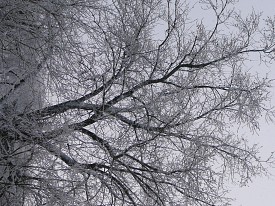Don't Let the Polar Vortex Ruin Your Home!
 It's brutally cold across much of the US, which has many people huddling indoors and seeking shelter. While you're staying warm inside, though (or calling your HVAC technician to find out why the heater isn't working), it's important to remember that your home is suffering from the polar vortex too. With extreme weather can come some risks that might not ordinarily present themselves, even when you're used to cold weather -- after all, Chicago is so cold right now that even the polar bear doesn't want to go outside.
It's brutally cold across much of the US, which has many people huddling indoors and seeking shelter. While you're staying warm inside, though (or calling your HVAC technician to find out why the heater isn't working), it's important to remember that your home is suffering from the polar vortex too. With extreme weather can come some risks that might not ordinarily present themselves, even when you're used to cold weather -- after all, Chicago is so cold right now that even the polar bear doesn't want to go outside.
The problem with buildups of snow and ice is that as water freezes, it swells. If it doesn't have room to expand, that's not really a problem: the freezing water will simply push right through. That's why pipes explode, roads crack, trees break apart, and roofs develop damage in ice storms. Even if your home is fitted for extreme cold, it might not be ready to handle temperatures even colder than normal.
Hopefully your pipes are already well-insulated against cold. If they aren't, you may be calling a Chicago plumber as we speak to have them repaired. You may also want to consider using a pipe warmer, a cable that keeps pipes above freezing -- or you can DIY a version with a portable heater or infrared lamp. Be careful when using electricity around pipes: make sure there are no leaks or other safety issues. Keep your faucets on a slight drip with warm water to keep water flowing (and use a bucket to save the water and use it for flushing).
How about your roof? We know you don't relish the thought of going up there, but you may have a buildup of snow and ice on the roof, and that's not good. If it forms into a solid block known as an ice dam, it creates majestic icicles...but can also tear shingles apart, destroy gutters, and, oh, dump water into your house. You can install heated cables under your eaves to prevent the formation of ice dams, and if necessary, use a roof rake to pull accumulations of snow off. Please don't clamber up on the roof to break up ice, because that's extremely dangerous.
For the long term, contact your roofer about regulating heat in your attic and roof area more effectively. Ice dams form because your eaves are not as warm as the rest of the roof, which is the result of inefficient circulation and insulation. This costs you money on energy in addition to threatening your lovely roof!
If you haven't already, have your furnace tuned up and your chimney cleaned, because functional heating systems are critical for making it through harsh weather. You'll save money on energy costs by keeping your heating system running at peak efficiency, and you'll also have a reduced risk of fire and other problems, including catastrophic failure in extreme cold. And install carbon monoxide detectors -- they could save your life.
Trimming tree branches is also advisable, although you shouldn't go out in dangerous temperatures or in the middle of an ice storm to do it. Make sure overhanging branches are trimmed away from your home, outbuildings, vehicles, and walkways. If they get overloaded with ice, they could fall, injuring people or property. Older trees should be removed, as they may pose a safety risk.
While you're dealing with harsh weather, please remember to shovel the sidewalk in front of your house. It's your responsibility, and it will make it easier for other members of the community to get around, including older adults and disabled people who might be relying on navigable sidewalks to get where they need to go. If you see that a neighbor is having trouble keeping her sidewalk clear, offer to help out!
Katie Marks writes for Networx.com.
Looking for a Pro? Call us (866) 441-6648

Plumbing Average Costs
Plumbers Experiences

Emergency Fencing Repair After A Tree Fell On My Chain Link Fence

Find A Handyman Who Responds Fast And Knows His Stuff



